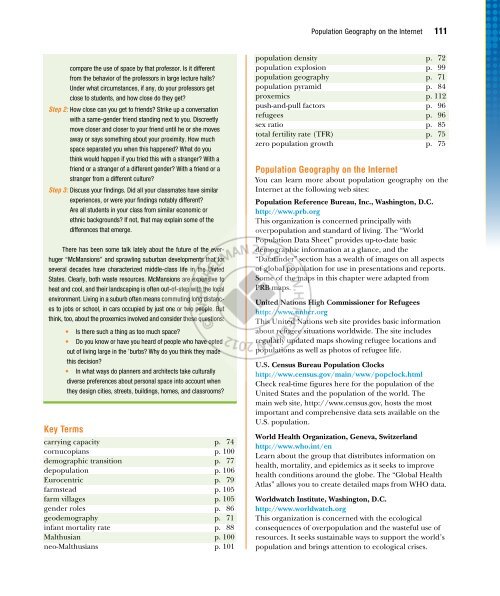Chapter 3 Population Geography - W.H. Freeman
Chapter 3 Population Geography - W.H. Freeman
Chapter 3 Population Geography - W.H. Freeman
Create successful ePaper yourself
Turn your PDF publications into a flip-book with our unique Google optimized e-Paper software.
<strong>Population</strong> <strong>Geography</strong> on the Internet 111<br />
compare the use of space by that professor. Is it different<br />
from the behavior of the professors in large lecture halls?<br />
Under what circumstances, if any, do your professors get<br />
close to students, and how close do they get?<br />
Step 2: How close can you get to friends? Strike up a conversation<br />
with a same-gender friend standing next to you. Discreetly<br />
move closer and closer to your friend until he or she moves<br />
away or says something about your proximity. How much<br />
space separated you when this happened? What do you<br />
think would happen if you tried this with a stranger? With a<br />
friend or a stranger of a different gender? With a friend or a<br />
stranger from a different culture?<br />
Step 3: Discuss your findings. Did all your classmates have similar<br />
experiences, or were your findings notably different?<br />
Are all students in your class from similar economic or<br />
ethnic backgrounds? If not, that may explain some of the<br />
differences that emerge.<br />
There has been some talk lately about the future of the everhuger<br />
“McMansions” and sprawling suburban developments that for<br />
several decades have characterized middle-class life in the United<br />
States. Clearly, both waste resources. McMansions are expensive to<br />
heat and cool, and their landscaping is often out-of-step with the local<br />
environment. Living in a suburb often means commuting long distances<br />
to jobs or school, in cars occupied by just one or two people. But<br />
think, too, about the proxemics involved and consider these questions:<br />
Key Terms<br />
• Is there such a thing as too much space?<br />
• Do you know or have you heard of people who have opted<br />
out of living large in the ’burbs? Why do you think they made<br />
this decision?<br />
• In what ways do planners and architects take culturally<br />
diverse preferences about personal space into account when<br />
they design cities, streets, buildings, homes, and classrooms?<br />
carrying capacity p. 74<br />
cornucopians p. 100<br />
demographic transition p. 77<br />
depopulation p. 106<br />
Eurocentric p. 79<br />
farmstead p. 105<br />
farm villages p. 105<br />
gender roles p. 86<br />
geodemography p. 71<br />
infant mortality rate p. 88<br />
Malthusian p. 100<br />
neo-Malthusians p. 101<br />
population density p. 72<br />
population explosion p. 99<br />
population geography p. 71<br />
population pyramid p. 84<br />
proxemics p. 112<br />
push-and-pull factors p. 96<br />
refugees p. 96<br />
sex ratio p. 85<br />
total fertility rate (TFR) p. 75<br />
zero population growth p. 75<br />
<strong>Population</strong> <strong>Geography</strong> on the Internet<br />
You can learn more about population geography on the<br />
Internet at the following web sites:<br />
<strong>Population</strong> Reference Bureau, Inc., Washington, D.C.<br />
http:// www.prb.org<br />
This organization is concerned principally with<br />
overpopulation and standard of living. The “World<br />
<strong>Population</strong> Data Sheet” provides up-to-date basic<br />
demographic information at a glance, and the<br />
“Datafinder” section has a wealth of images on all aspects<br />
of global population for use in presentations and reports.<br />
Some of the maps in this chapter were adapted from<br />
PRB maps.<br />
United Nations High Commissioner for Refugees<br />
http:// www.unhcr.org<br />
This United Nations web site provides basic information<br />
about refugee situations worldwide. The site includes<br />
regularly updated maps showing refugee locations and<br />
populations as well as photos of refugee life.<br />
U.S. Census Bureau <strong>Population</strong> Clocks<br />
http:// www.census.gov/main/www/popclock.html<br />
Check real-time figures here for the population of the<br />
United States and the population of the world. The<br />
main web site, http://www.census.gov, hosts the most<br />
important and comprehensive data sets available on the<br />
U.S. population.<br />
World Health Organization, Geneva, Switzerland<br />
http:// www.who.int/en<br />
Learn about the group that distributes information on<br />
health, mortality, and epidemics as it seeks to improve<br />
health conditions around the globe. The “Global Health<br />
Atlas” allows you to create detailed maps from WHO data.<br />
Worldwatch Institute, Washington, D.C.<br />
http:// www.worldwatch.org<br />
This organization is concerned with the ecological<br />
consequences of overpopulation and the wasteful use of<br />
resources. It seeks sustainable ways to support the world’s<br />
population and brings attention to ecological crises.

















